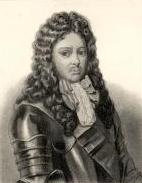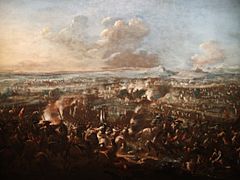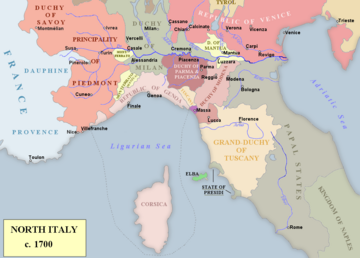Louis d'Aubusson de La Feuillade facts for kids
Quick facts for kids
Louis, Vicomte d'Aubusson, Comte de La Feuillade, Baron de la Borne, Baron de Pérusse, Seigneur de Felletin, 7th duc de Roannais
|
|
|---|---|

1702 Engraving of de La Feuillade
|
|
| Governor of La Dauphiné | |
| In office 1691–1719 |
|
| Personal details | |
| Born | 30 March 1673 Marly-le-Roi, Île-de-France |
| Died | 29 January 29 January 1725 (aged 51) Marly-le-Roi, Île-de-France |
| Resting place | Couvent des Théatins, Paris |
| Spouses | (1) Charlotte-Thérèse de la Vrilliere (1692-1697) (2) Marie Thérèse Chamillart (1701-1716) |
| Awards | Chevalier, Order of Saint Louis |
| Military service | |
| Allegiance | |
| Years of service | 1688–1706 |
| Rank | Marshal of France |
| Unit | Cavalry |
| Battles/wars | Nine Years War Philippsburg; Walcourt; Fleurus; Landen; Charleroi War of the Spanish Succession Nice; Siege of Turin |
Louis d'Aubusson de la Feuillade, Duke of Roannais (born March 30, 1673 – died January 28, 1725) was a French army officer and a member of the royal court. He fought in two major wars: the Nine Years War and the War of the Spanish Succession.
Contents
Early Life and Family

Louis d'Aubusson de la Feuillade was born on March 30, 1673. His birthplace was Marly-le-Roi, a town near the royal summer palace of Château de Marly. This palace was a favorite spot for King Louis XIV. Being allowed to live there showed that Louis's family was highly favored by the king.
His father, François d'Aubusson de La Feuillade, was also a soldier and a courtier. A courtier is someone who attends the royal court. Louis's uncle, Georges d'Aubusson de La Feuillade, was the Bishop of Metz.
Louis's mother was Charlotte de Gouffier. Her brother, Artus de Gouffier, was the 5th Duke of Roannais. Artus was a close friend of the famous writer and mathematician Blaise Pascal. In 1667, Artus decided to join a monastery. He gave his titles and property to Louis's father, François. In return, François agreed to marry Charlotte. Because of this, Louis was sometimes known as the 'Duke of La Feuillade'.
Louis was married twice. His first wife was Charlotte-Thérèse de la Vrilliere, whom he married in 1692. She passed away in 1697. In 1701, he married Marie Thérèse Chamillart. She was the daughter of Michel Chamillart, who was the Minister of War. Louis did not have any children from either marriage. Because of this, the title of Duke of Roannais ended when he died in 1725.
Military Career and Challenges
In 1688, Louis d'Aubusson de la Feuillade started his military career. He formed a cavalry regiment to fight in the Nine Years' War. His regiment took part in several important battles. These included the Battle of Walcourt, the Battle of Fleurus, and the Battle of Landen.
After the Battle of Landen, a controversy arose. Some people claimed that La Feuillade disappeared during the battle. They said he only reappeared at the end. This was a serious accusation. He had to write a letter to his first father-in-law to deny it.
A few years later, another problem occurred. After his uncle, Georges de la Feuillade (the Bishop of Metz), died in 1697, the church's financial records were checked. A large amount of money was found to be missing. A report suggested that La Feuillade had taken the money. This happened when he visited his uncle. King Louis XIV was convinced by the evidence. He wanted to remove La Feuillade from the army. However, a friend of his father-in-law, Louis de Pontchartrain, convinced the king not to.
The Treaty of Ryswick ended the Nine Years' War in 1697. La Feuillade's regiment was then disbanded. Despite his past issues, he was brought back into the army in 1702. This was during the War of the Spanish Succession. He was promoted to a higher rank in 1703. He was then sent to the French army in Italy. Many believed this promotion was due to the influence of his father-in-law, Michel Chamillart, who was the Minister of War.
Some people at the time did not think highly of La Feuillade. They described him in harsh ways.
The Siege of Turin
Victor Amadeus II, the ruler of Savoy, was initially an ally of France. However, he switched sides in October 1703. La Feuillade was made second-in-command to Vendôme. Vendôme was the French commander in Italy. La Feuillade was given the job of taking control of Villefranche and the County of Savoy. These areas are now part of modern-day France.
By the end of 1705, most of this task was done. The main goal for 1706 was to capture Victor Amadeus's capital city, Turin. La Feuillade began the siege of Turin on May 12 with an army of 48,000 soldiers. The city was completely surrounded by June 19.
Turin's defenses had two main parts. There was the outer 'City' where people lived and worked. Then there was the 'Citadel' at its center. La Feuillade and Vendôme planned to dig trenches around the City. They would then blast the Citadel. This method was called the 'Coehoorn method'. However, the Citadel's defenses had been greatly improved since 1696. The French military engineer Vauban had designed these improvements. Much of the Citadel's defenses were now underground.
Vauban suggested that they should capture the City first. This would allow their cannons to aim at the base of the Citadel's walls. But his advice was not followed. La Feuillade was also criticized for spending too much time chasing Victor Amadeus. Victor Amadeus had escaped from Turin with 6,000 cavalry soldiers.

The French army faced a major defeat at the Battle of Ramillies on May 23. This changed the situation in Italy. As a result, Vendôme was sent to Northern France in July. Philippe, Duke of Orléans took command in Italy. He was advised by Marshal Ferdinand de Marsin. Orléans joined La Feuillade at Turin. Their combined forces attacked the city three times between August 27 and September 3. Each attack was pushed back with heavy losses.
The Siege of Turin ended in September. A relief force led by Prince Eugene broke through the French siege lines near Collegno.
Later Life and Legacy
After the defeat at Ramillies, France's northern border was under pressure. King Louis XIV needed to end the war in Italy. In March 1707, he made an agreement called the Convention of Milan with Emperor Joseph. The French army withdrew its remaining soldiers from Italy. They gave control of Milan and Mantua to Austria. In return, the French soldiers were allowed to return to France safely. This meant they could be sent to fight in other areas.
This defeat at Turin marked the end of La Feuillade's military career. He was criticized for leaving the siege to chase Victor Amadeus. However, he was given the honorary title of Marshal of France in 1724.
During the time known as the Régence (1715-1723), which followed Louis XIV's reign, La Feuillade was offered a job as Ambassador to Rome. He turned it down. His position as Governor of the Dauphiné was given to Louis, later Duke of Orléans in 1719.
Louis d'Aubusson de la Feuillade was buried in the Couvent des Théatins in Paris. This building was later torn down in 1825. As he had no children, the title 'Duke of Roannais' ended with his death. However, his other titles and lands passed to Jacques d'Aubusson, Baron Miremont.
See also
 In Spanish: Louis d'Aubusson de la Feuillade para niños
In Spanish: Louis d'Aubusson de la Feuillade para niños


